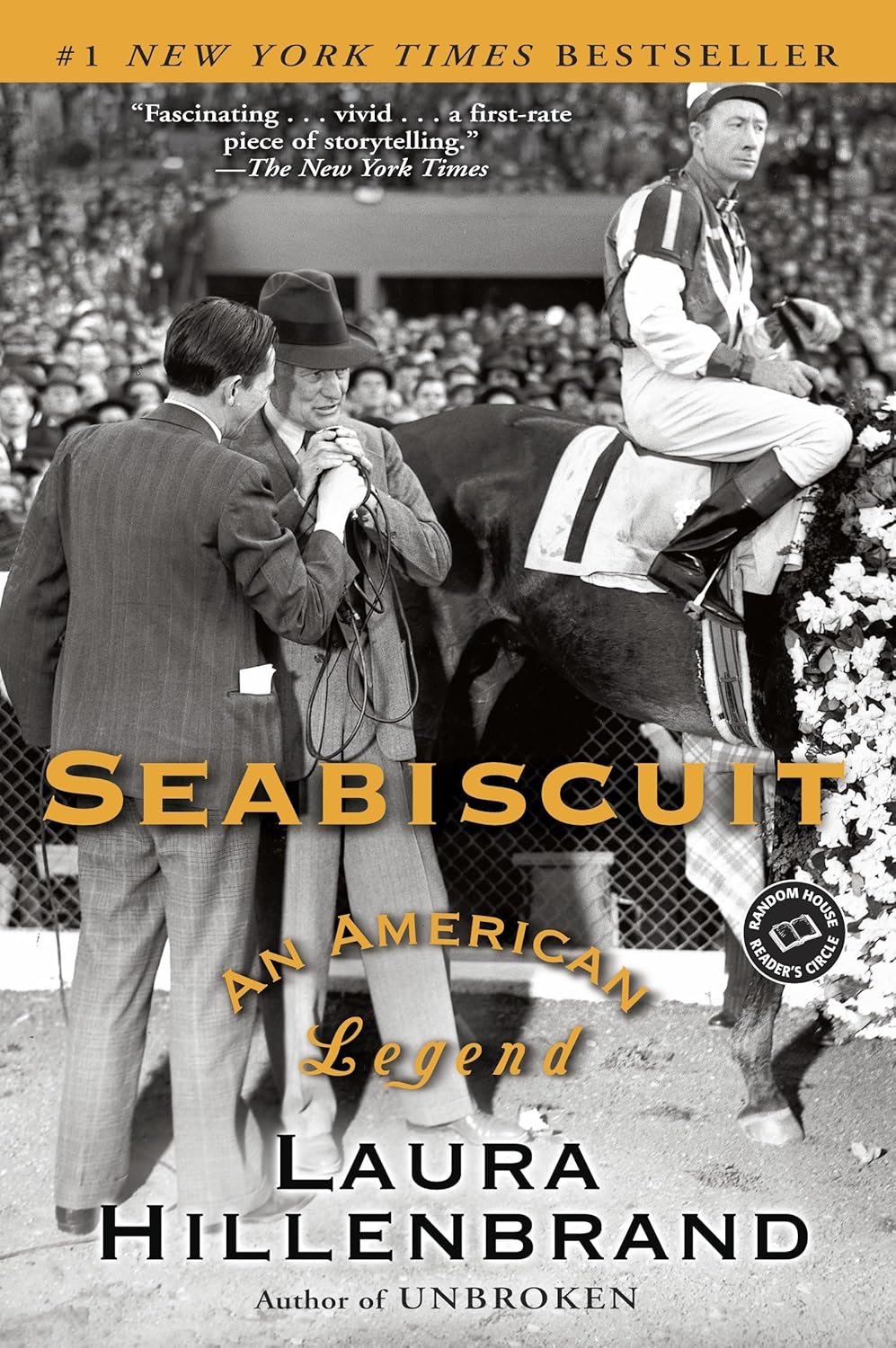Seabiscuit
 0-449-00561-5
0-449-00561-5
Review note: One of the staff members in the earlier days of Facebook had Hillenbrand as a friend. Seabiscuit was out then. –Booklight staff
In case you ever want to know how long it takes books to get that weathered yellowing that books of antiquity often characteristically possess, the answer is about 25 years it seems, since the review copy of this work looked like it might have been around as a witness to the races of Seabiscuit during his prime.
Hillenbrand has a nose for stories. Her previous work, Unbroken, was reviewed by this site. Seabiscuit as a narrative theme, echoes some of what Unbroken encapsulated. The idea of the unlikely or unknown coming into a position of world notice only to encounter some insurmountable-seeming obstacle is something that both works share as the subjects of both books had to face uncommon amounts of hardship.
What makes Seabiscuit captivating though, is not necessarily the writing, though it is good, but the story itself. Hillenbrand is able to weave the narrative structure together such that the reader is transported back to the early 30’s when Seabiscuit was starting his ascent into national domination of horse racing.
Some of “The Biscuit’s” retinue is well known since the tale is frequently crossing paths with the likes of Bing Crosby who is surrounded by the kind of people one would expect for his time and place.
If you have ever wondered what the profession of a horse jockey is like, Seabiscuit is an eye-opening encounter of the hardships and dangers incumbent on those who pursued the sport and profession. In short, the conditions were barely above awful, and it is a wonder that any jockey stuck around through those years and even now since the same dangers are present.
What one learns, however, is that the jockeys are riding for freedom–or a kind of transcendence that only horse racing provides and arguably only Seabiscut could uniquely channel such than the entire US paid attention to his races above concerns even of a burgeoning World War II. We learn in the book that FDR kept diplomats waiting just to hear whether or not Seabiscuit would win a certain race against another horse that is still well-known who went by the name of War Admiral.
There is a kind of chaos that sets up around the races and the characters in them–and it is not a unique occurrence since it seems to happen in almost each race. Sometimes it happens during the race, and this usually portends a jockey either being seriously hurt or dead.
Seabiscuit seems, at one point or another, to trick everyone or to play tricks on everyone. The beginning narrative deals with Tom Smith, an enigmatic cowboy type, coming into the ranch and discovering what Seabiscuit’s psychology is after having discovered him. At the same time “Red” Pollard, Seabiscuit’s first real jockey, starts to comprehend what it means to motivate Seabiscuit to win. The fact that Seabiscuit requires motivation is an interesting spin, since most horses naturally seem to run, but Seabiscuit is not a “natural horse” as the story shows.
Pollard acts, at first, as Seabiscuit’s savior, and then later Seabiscuit acts more as his. The two of them are intertangled, and although Seabiscuit is ridden by another jockey for a time by the name of Wolf, eventually everything comes back to Pollard at a crucial moment for both jockey and horse.
We also learn about Charles S. Howard, the owner of Seabiscuit, who also kicks car ownership into existence with the early sales of Buicks in California assisted, in a major way, by the California earthquake of 1906.The Quake, we learn, made horses sparse, and cars were, on the contrary, plentiful. (so long as you bought them from Charles S. Howard’s lot) Howard, paradoxically, gets into horse racing, which is the animal he is replacing with the newest technology.
The pacing of Seabiscuit is fast, but it never becomes tedious. The story is worth at least one reading, and probably several additional ones as a kind of reminder about adversity and what can be done when the world arrays itself against you–maybe especially the media, gossip, and slander. (and your competition) Seabiscuit overcame it all, and became a legend. So too did the people who managed him. Somewhere in there though, a large portion of faith was involved, because in many given instances, things looked bad at best and hopeless at worst. Know anyone who can use some inspiration?